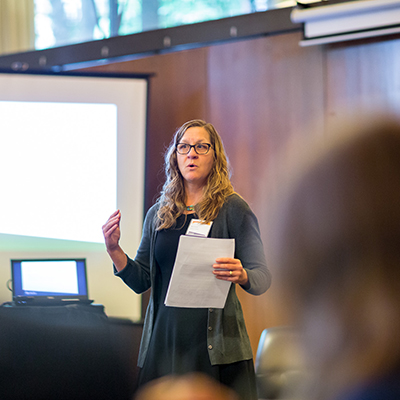The Future of SNAP

Photos by: Jonathan Fong
The federal food stamps program known as the Supplemental Nutrition Assistance Program (SNAP) faces an uncertain political and budgetary future. Professor Hilary Hoynes, in partnership with the Berkeley Food Institute, convened a day-long, interdisciplinary workshop of policy makers, community leaders and academics to engage the critical quesitons around this important safety net program.
"The objective was to have a structured conversation about SNAP with those who work most closely with it,” says Professor Hoynes, who holds the Haas Distinguished Chair in Economic Disparities.
The workshop consisted of three panels: 1) SNAP as a food nutrition program, 2) program distribution and take up and 3) SNAP as part of the larger safety net. Each panel featured an academic, a policy practitioner and a community leader. The day also included table discussions around specific topics moderated by Maria Echaveste of the Chief Justice Earl Warren Institute on Law and Social Policy and a poster session where graduate students from the Goldman School, the School of Public Health and others presented their work. Participants included (among others) senior policymakers and administrators from Washington (USDA), the counties of Alameda, Marin and Monterey, the Alameda and Marin County food banks, and UC Berkeley researchers.

“I hadn't anticipated the power of convening people on the university campus,” says Professor Hoynes. “Academics take for granted the opportunity to reflect on the big picture and share ideas freely. Many working in the trenches don’t have that kind of luxury.”
She notes that researchers benefited from the conversations as well, especially from the chance to learn from those directly serving the community.
"For example, academics are very interested in "take up," the number of eligible people who choose to take advantage of any social program,” she says. “Medicare take up is nearly 100%, while Medicaid has only about 75%. Why is that? From community workers, we learn specific stories about the habits and preferences of, for example, the elderly or certain ethnic or cultural groups that help us flesh out the necessary abstractions of research.”
Professor Hoynes is in the process of synthesizing the conversation into a short policy paper which will be made available here and via the Berkeley Food Institute and Haas websites.


 Master of Public Policy
Master of Public Policy
 Master of Public Affairs
Master of Public Affairs
 Master of Development Practice
Master of Development Practice
 Doctoral Program
Doctoral Program
 Global and Executive Programs
Global and Executive Programs
 Undergraduate Programs
Undergraduate Programs

 Diversity, Equity, Inclusion
Diversity, Equity, Inclusion
 Student Groups
Student Groups
 Alumni
Alumni
 Directories
Directories

 Faculty
Faculty
 Publications
Publications
 Working Papers
Working Papers
 Centers
Centers
 News Center
News Center
 Policy Initiatives
Policy Initiatives

 For Students
For Students
 For Employers
For Employers
 Career Events
Career Events
 Employment Statistics
Employment Statistics
 Client-based Projects
Client-based Projects
 About GSPP
About GSPP
 Events
Events
 Make a Gift
Make a Gift
 Find a Program
Find a Program
 Find a Faculty Member
Find a Faculty Member
 Find a Center
Find a Center